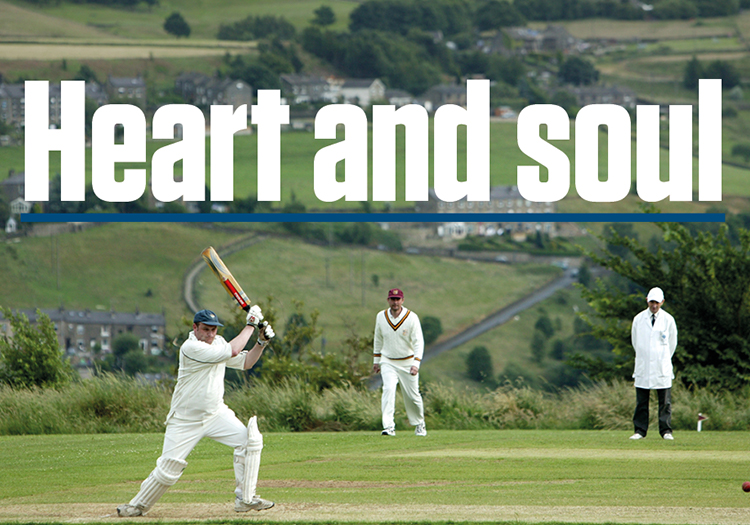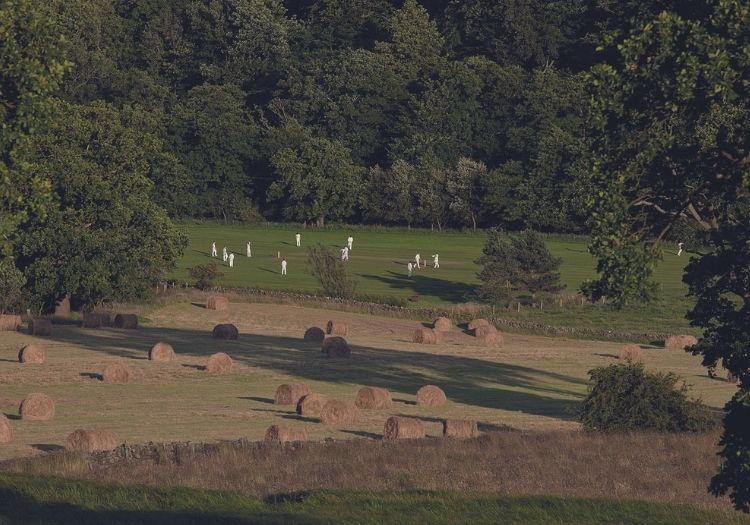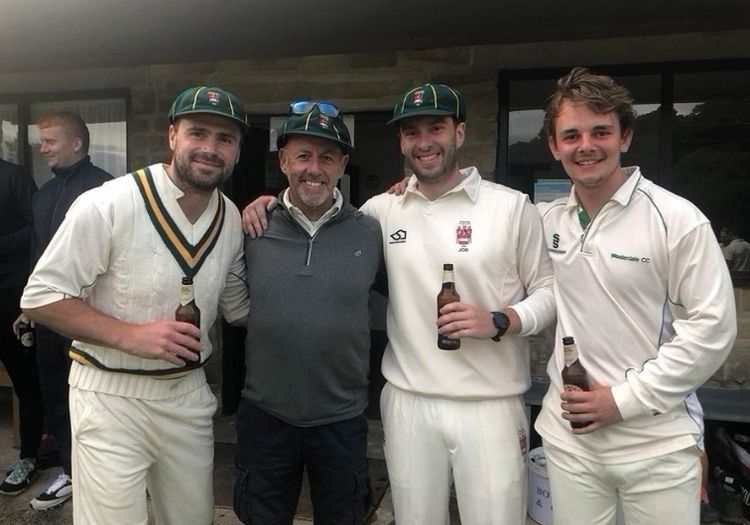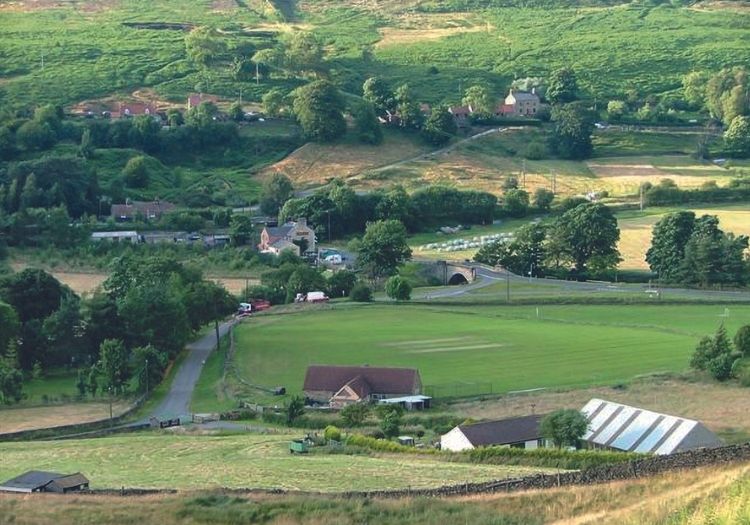
SIMON HUGHES embarks on a four-match tour of the North York Moors which helps him reconnect with the game's roots
First, a bit of history. On a wall in Goodwood House in Sussex is a framed print of some ‘articles of agreement’ laid down before an 18th century cricket match. This was for the encounter between the second Duke of Richmond’s side and a team formed by Mr Alan Brodrick of Surrey played at Goodwood in 1727. This ‘agreement’ was effectively the game’s first set of Laws. At that point the pitch was 23 yards long, the teams were 12-a-side and the team ‘owners’ were permitted to contest decisions with the umpires. They often did.
This area of West Sussex and the weald of Kent is generally regarded as the place from where cricket originated. There is a connection with sheep farming, as it was shepherds that first played a primitive version of the game using a low gate like a widened croquet hoop – under which sheep normally passed – as a wicket. Pitches were rudimentary – often just the least bumpy strip of grass they could find in the middle of a field. The bat was more like a hockey stick. Kent and Sussex staged the first county matches.
There is more than a suspicion, however, that cricket was also evolving in the north in the late 17th and early 18th centuries, particularly in Yorkshire. In his acclaimed book More than a Game, John Major relates that court documents from Hillham, east of Leeds, in 1620 state “terr in loco voc Crickitt” translated as “known to the locals as a cricket ground.” There was certainly plenty of cricket activity in the Richmond (North Yorkshire) area soon after that time.
You don’t need a rich imagination to comprehend what cricket was like then. In fact you can see it for real – well sort of – on the North York Moors. I have just been on a cricket tour there. I was part of the annual visit of wandering London club Millfields CC who have played matches in the area for 35 years.

Westerdale cricket ground
The superficial bleakness of the moors seen from the A64 conceals great riches, not least some of the most serene cricket grounds in the world. Suddenly from the harsh, featureless landscape of heather and grassland you plunge deep into forested valleys, bisected by rivers and becks beside which cricket fields almost impossibly perch. At Westerdale, the brooding sweep of Blakey Ridge looms up behind the bowler’s arm at one end, acting as a two-tone sightscreen. At the picturesque village of Goathland, sheep stray off the nearby moorland onto the village green and neighbouring cricket field, feasting on the outfield’s rye grass, an alternative interpretation of the familiar cricketing phrase ‘nibbling outside off stump’.
The air is occasionally rent with the whistle from an engine on the nearby steam railway. At Glaisdale CC, reached via a steep plummet down Limber Hill, a tight meander of the tree-lined River Esk almost entirely circles the ground. At High Farndale, the outfield grass is kept uniquely long (perhaps the sheep aren’t hungry) and there is a tree on the field at cow corner. Spout House CC has one playing strip on the side of a steep hill and you can only register a six if you hit the ball over the old stone perimeter wall.
Cricket in this region has a pure and timeless feel. Players arrive changed, helmets are rarely worn, batting orders are sometimes chosen by drawing lots, the boundary is delineated not by rope or white markers but by leaving the grass longer (like the rough in golf). Pitches are sometimes indistinguishable from the outfield (but play better than they look). New batsmen are clapped to the wicket and there is barely any sledging, except at an umpire (from the batting side) failing to give a teammate lbw. Wooden stiles are located at regular intervals alongside the barbed wire perimeter to facilitate ball retrieval. Club houses are primitive. There is no bar or in some cases even electricity. Certainly no wifi. Not even a mobile phone signal.
"We discovered new places, hit a few in the middle, pulled off the odd diving stop, made new friends, helped support grassroots clubs and were obliged to manage without our mobile phones for entire days – isn’t that what cricket’s all about?"
Yet there is plenty of obvious talent. Willowy young bowlers fizz the ball down with robust, athletic actions, the fielding is sharp and committed, muscular farmers hit the ball cleanly through or over the infield with more than just an agricultural heave. At Westerdale Jonna Thompson, a water worker, hit me for the biggest six I’ve ever been struck for (admittedly assisted by a stiff wind). It cleared the road, landed in the middle of the next field and, necessitating the negotiating of a brook and two stiles, took 10 minutes to locate. He eventually got 70, including 12 off an over from our guest star for the day, Zimbabwe’s Shingirai Masakadza, who was pro-ing for
a nearby club.
Most of the teams here play in a Saturday league, some in a T20 version on Wednesday nights. But there is a growing feeling of isolation and difficulty in sustaining their cricket. James O’Donnell, a local history teacher and an excellent allrounder for Westerdale who briefly dreamed of turning pro, voices the sort of concerns that many clubs experience but that are felt more acutely here.
“The Esk Valley league which many of us played in folded in 2019,” O’Donnell said. “Originally there were at least 10 teams, but they gradually fell away. First to go was Ugthorpe. Then Mulgrave who decided to enter the more reputable Scarborough Beckett league. We (Westerdale) soon followed and then Danby. Some teams came and went such as Hinderwell and Boosbeck, but as the standard dropped and dropped more teams wanted to play better cricket, whereas some stopped altogether. The teams from the Eskdale league that still play are us, Danby, Castleton and Loftus and we all now play in the Langbaugh Cricket League. The others who have survived and are still playing are Glaisdale, Goathland and Mulgrave. The Esk Valley evening league has still survived however and is played on Wednesdays. There are 16 teams in that.”

Westerdale welcome Simon Hughes as an honorary member with James O’Donnell (second from right)
There is great dependency on a few families, and dedicated individuals to sustain these clubs. The Westerdale team, founded in the 1930s, often consists of four Thompsons and three Dowsons.
“Arthur Thompson was a great stalwart and his son David is our club secretary. Joe Thompson is the real hero of the club. He played well in to his late 60s and along with being a good cricketer spent so much of his life as secretary, chairman, president and latterly honorary life member. The pavilion was built on the back of Joe’s efforts for example. Paul (Joe’s son) and Dave (Arthur’s son) have produced two and three sons respectively who all play cricket for us to this day.
“Most live fairly locally, perhaps within a 15 to 20-mile radius. Some have moved further out. The rising house prices and changing demographic of the area – more second home ‘weekenders’ – has had an impact on that. With the exception of myself nearly all of our players work in some form of local industry such as Yorkshire Water, builders, electricians, farmers or in the local potash mines.
“These small communities can’t sustain colts sections and there is definitely a lack of players coming through. Many of our players have moved on to pastures new and have family commitments or other priorities. With our lack of facilities, the amount of rival sports and a more digital world it is hard not only to recruit, but retain players. If more funding were made available then clubs could all have net facilities which would help. If there are any local youngsters wanting to play the lack of a training area is an issue.”

Castleton cricket ground
Yorkshire’s Adam Lyth is the most celebrated player from the North York Moors area, but few make it into professional circles. O’Donnell thinks this is unjust. “We must not be forgotten by the larger authorities. There’s a lot of talent in local leagues and much of it is overlooked because it is seen as ‘village’. Village or not, these local communities are an essential part of both Yorkshire culture and provide players who go on to all sorts of levels. National premier leagues are all well and good, but take away the heart and soul of local village leagues and we all suffer as a result. Not to mention the pubs! Our current local leagues are competitive, well fought for and many local volunteers are desperate to keep them going for future generations.”
It’s the same story at other nearby clubs who have to show extensive patience and resourcefulness. At Goathland, long serving member Angus Nicholson travels down from his hillside home three nights a week to cut and roll the pitch and outfield. It takes him about three hours, and with a busy job he is finding the commitment increasingly demanding but worries that there is no-one else to take over. The pavilion was a rickety shed, but fundraising in the local community enabled the construction of a new clubhouse which is vitally multi-purpose. It acts as a village library, coffee bar, yoga studio, and as a space for long-sword dancing practice, a North Yorkshire ritual.
At Glaisdale, retired local resident Mark Hollingworth keeps the club going, maintaining the outfield, repairing the clubhouse roof, servicing the toilets in an adapted shipping container, and of course preparing the pitch. For a club in a valley bottom surrounded by the River Esk the surface was remarkably hard with good carry. I managed to bowl my first bouncer for about 20 years. But Hollingworth had the last laugh. He carved out a cultured half-century with what looked like a pre-war bat and saw his team to victory.
The global game: Now there's a bloke with a decent arm…
What is really noticeable about this area is that cricket clubs are the heart of the community. There are few churches on the moors, and no shopping centres or gyms (which are the new ‘churches.’) Entire extended families congregate at the club with their pets, and while the dads (and the occasional daughter) play, older relatives keep an eye on the kids, who, because of the lack of wifi and mobile signal rendering devices useless, frolic about in the grass as kids used to do. Then after the match and a communal beer in front of the clubhouse everyone repairs to the nearest pub for a game of quoits and a slap-up dinner. It is almost the land that time forgot.
It was an enjoyable four-match tour, originally six but truncated because members of two opposition teams were pinged by the NHS Covid app. The Millfield side, usually featuring three Coopers and three Hugheses, were no match for a young and energetic Danby side, bowled out a rudimentary Goathland team for 50, were outgunned by Westerdale’s range of strikers who even took the Zimbabwe international for eight an over, and seen off in the rain and fading light by the veteran Hollingworth at Glaisdale.
Won one, lost three isn’t a great playing record after an 800-mile round trip but we discovered new places, and hit a few in the middle and pulled off the odd diving stop and made new friends and helped support grassroots clubs and were obliged to manage without our mobile phones for entire days. Isn’t that what ‘real’ cricket is all about?
This article was published in the Summer edition of The Cricketer - the home of the best cricket analysis and commentary, covering the international, county, women's and amateur game